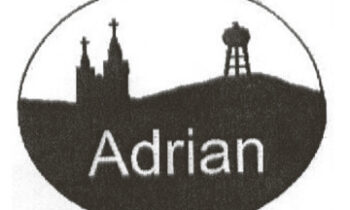By Deb Kroon
Review Staff Writer
Have you ever taken a good look at the soil that is under our feet? Most of us don’t take the time to really look at it and very few of us know what soil is comprised of. Soil is the backbone of our very being Everything can be traced back to soil, including us if we believe in the Bible.
Samantha Croat, a SDSU graduate and soon to have a Masters Degree from NDSU, has made it her life-time mission to do for us what we take for granted, taking care of our soil. Sam graduated with a degree in Agronomy and will soon graduate with a Master’s in Soil Science.
Sam grew up on a farm north of Rushmore, MN. She is the daughter of Mark and Micki Croat. She has always loved farm life and knew she wanted to pursue a career that was farm related. During her years at SDSU she spent a lot of time studying the soil. “For one class we had to dig a pit or trench and describe what we found, the color and texture, nutrients, everything in each layer from the top of the hole to the bottom,” she explained to me. “ There is so much color in soil. The whole process fascinated me. I loved doing it! You can tell how the soil was formed. I knew I wanted to learn more.” Sam had the opportunity during these years to travel internationally, making trips to China, South Africa and Ecuador. She studied different types of soils and different methods of farming it. “These trips have given me opportunities to learn things that will definitely change my life. I am so thankful I had these chances.”
In September of 2013, farmer Steve Jensen smelled crude oil as he was working his wheat field near Tioga, ND. While combining, he notice that the tires of his combine were covered in oil. He had found an oil spill in his field. The spill was not far from the site where oil had been discovered in 1951. The Texas based oil company Tesoro, now known as Andeavor, reported that the spill had resulted from a possible lightening strike to the 6” diameter steel pipeline. The oil spill turned out to be the largest onshore oil spill in U.S. history. Approximately 840,000 gallons of oil had leaked onto the Jensen’s 70 acres of land. Less that 1/3 of the oil was recovered. North Dakota Health Department environmental scientist Bill Suess said that about 1.4 million tons of soil had to be excavated from the site and treated.
When the spill happened, Sam had not come to NDSU, but she would get in on the cleanup process, which took five years to complete. She explained the process of “burning” the oil out of the soil. “A payloader would dump a bucket of the contaminated soil into a drum that was heated to 250°C (482°F), similar to asphalt. The oil burns off as carbon dioxide and oxygen.” After this process is where the NDSU Soil Science department came into the picture. “After the spill and after the company had the soil ‘burned’, they came to NDSU, to the soil science department, to begin to study the soil and figure out the best way to make the soil usable again. I came to NDSU in January of 2016 and had the opportunity to work with the program. What we were looking at was what nutrients and how much of them would need to be added to make the soil able to sustain crops. Was it phosphorus and how much? What would the effects be on the rest of the environment?” she explained. “What we found was that the soil bounced back quickly. The microorganisms survived the burning. There were three scenarios to work with: we could use only the top soil that wasn’t contaminated, we could use the burnt soil, only and try to build it back up, or we could blend the good top soil with the burnt soil. It absolutely was not feasible to use top soil only-the amount needed was too great. The burnt soil did come back, but we weren’t happy with the amount of additives that would be added, so we found that if we mixed the burnt soil with the good top soil, we could get crops to grow, and not have to wait. By blending we found that the phosphorus levels were near normal. We planted wheat and peas, two crops grown in the area, and our yields were close to a thirty year county average.” The project is now complete and the Jensens are back in business. NDSU will continue to research methods of returning contaminated soil and the yields to normal numbers.
Being involved with this research gave Sam the chance to work with an international organization called the International Plant Nutrition Institute (IPNI) This is a science based, non-profit organization which is dedicated to the responsible management of plant nutrition for the benefit of the human family. IPNI began operating in 2007 and now has active programs on all of the continents except Antartica. IPNI addresses the world’s growing need for food, fuel, fiber and feed. The program’s coordinators and regional directors are all Ph.D. scientists. Through cooperation and partnering with respected institutes around the world, IPNI adds it’s strength to agronomic research, education, training and other endeavors. They are trying to reinforce best management practices for nutrient stewardship by encouraging the concept of applying the right product at the right time and the right place.
IPNI has a scholarship program that awards a scholarship to graduate students from all over the world working in soil science. “I knew a person who had won a scholarship and some of my colleagues encouraged me to apply,” Sam said. “I had to talk about my research and how it could affect people internationally. I was one of 31 winners from 11 countries this year. The scholarship is monetary and to be awarded it by IPNI is a great accomplishment. There are no strings attached to this scholarship, it is awarded to help the graduate any where they need it.
Sam had just finished her thesis for her Master’s degree when we talked. For the next few weeks, she will be preparing for her final presentation defense. Her professors will be reading her thesis and she goes before them in December to defend her research and the results. After this presentation defense, the professors will decide if she is at a master’s level. If they determine she is, she will graduate later in December with a Master’s Degree in Soil Science.
I asked of her plans for after graduation. She explained her options; she could go on for her Ph.D. or look for employment. “I would like to work in western North Dakota with the oil companies as an environmental specialist/scientist, which is essentially a cross between a scientist and a project manager. There will always be oil accidents, from an oil spill to a salt water spill. They happen daily, from a barrel to something larger. Both spills are huge. Oil spills are treatable, but salt water spills cannot be fixed. Understanding how to clean them up and restore the soil is really important and that’s what I would be doing. I would determine the method of containment and the cleanup. There are many methods, but it would be up to me to decide which method is best for each situation. I would oversee the clean up and monitor the soil and the crop growth.”
Samantha Croat has a great future ahead of her. It was great to spend time talking to someone who has such an understanding of a necessity (soil) for the world and the gumption to take on trying to educate the world on how to take care of such a precious resource, one area at a time. As long as we have scientists like her to keep an eye on what many of us take for granted, our soil and it’s health will continue to be our backbone for years to come. Congratulations Sam on the honor of your scholarship award and on your upcoming graduation, and good luck with your new career.






